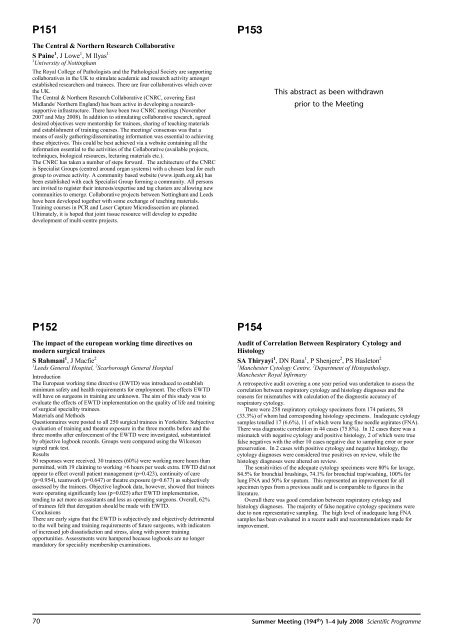2008 Summer Meeting - Leeds - The Pathological Society of Great ...
2008 Summer Meeting - Leeds - The Pathological Society of Great ...
2008 Summer Meeting - Leeds - The Pathological Society of Great ...
You also want an ePaper? Increase the reach of your titles
YUMPU automatically turns print PDFs into web optimized ePapers that Google loves.
P151P153<strong>The</strong> Central & Northern Research CollaborativeSPaine 1 ,JLowe 1 ,MIlyas 11 University <strong>of</strong> Nottingham<strong>The</strong> Royal College <strong>of</strong> Pathologists and the <strong>Pathological</strong> <strong>Society</strong> are supportingcollaboratives in the UK to stimulate academic and research activity amongstestablished researchers and trainees. <strong>The</strong>re are four collaboratives which coverthe UK.<strong>The</strong> Central & Northern Research Collaborative (CNRC, covering EastMidlands/ Northern England) has been active in developing a researchsupportiveinfrastructure. <strong>The</strong>re have been two CNRC meetings (November2007 and May <strong>2008</strong>). In addition to stimulating collaborative research, agreeddesired objectives were mentorship for trainees, sharing <strong>of</strong> teaching materialsand establishment <strong>of</strong> training courses. <strong>The</strong> meetings' consensus was that ameans <strong>of</strong> easily gathering/disseminating information was essential to achievingthese objectives. This could be best achieved via a website containing all theinformation essential to the activities <strong>of</strong> the Collaborative (available projects,techniques, biological resources, lecturing materials etc.).<strong>The</strong> CNRC has taken a number <strong>of</strong> steps forward. <strong>The</strong> architecture <strong>of</strong> the CNRCis Specialist Groups (centred around organ systems) with a chosen lead for eachgroup to oversee activity. A community based website (www.ipath.org.uk) hasbeen established with each Specialist Group forming a community. All personsare invited to register their interests/expertise and tag clusters are allowing newcommunities to emerge. Collaborative projects between Nottingham and <strong>Leeds</strong>have been developed together with some exchange <strong>of</strong> teaching materials.Training courses in PCR and Laser Capture Microdissection are planned.Ultimately, it is hoped that joint tissue resource will develop to expeditedevelopment <strong>of</strong> multi-centre projects.This abstract as been withdrawnprior to the <strong>Meeting</strong>P152<strong>The</strong> impact <strong>of</strong> the european working time directives onmodern surgical traineesSRahmani 1 ,JMacfie 21 <strong>Leeds</strong> General Hospital, 2 Scarborough General HospitalIntroduction<strong>The</strong> European working time directive (EWTD) was introduced to establishminimum safety and health requirements for employment. <strong>The</strong> effects EWTDwill have on surgeons in training are unknown. <strong>The</strong> aim <strong>of</strong> this study was toevaluate the effects <strong>of</strong> EWTD implementation on the quality <strong>of</strong> life and training<strong>of</strong> surgical speciality trainees.Materials and MethodsQuestionnaires were posted to all 250 surgical trainees in Yorkshire. Subjectiveevaluation <strong>of</strong> training and theatre exposure in the three months before and thethree months after enforcement <strong>of</strong> the EWTD were investigated, substantiatedby objective logbook records. Groups were compared using the Wilcoxonsigned rank test.Results50 responses were received. 30 trainees (60%) were working more hours thanpermitted, with 19 claiming to working >6 hours per week extra. EWTD did notappear to effect overall patient management (p=0.423), continuity <strong>of</strong> care(p=0.954), teamwork (p=0.647) or theatre exposure (p=0.677) as subjectivelyassessed by the trainees. Objective logbook data, however, showed that traineeswere operating significantly less (p=0.025) after EWTD implementation,tending to act more as assistants and less as operating surgeons. Overall, 62%<strong>of</strong> trainees felt that derogation should be made with EWTD.Conclusions<strong>The</strong>re are early signs that the EWTD is subjectively and objectively detrimentalto the well being and training requirements <strong>of</strong> future surgeons, with indicators<strong>of</strong> increased job dissatisfaction and stress, along with poorer trainingopportunities. Assessments were hampered because logbooks are no longermandatory for speciality membership examinations.P154Audit <strong>of</strong> Correlation Between Respiratory Cytology andHistologySA Thiryayi 1 ,DN Rana 1 , P Shenjere 2 , PS Hasleton 21 Manchester Cytology Centre, 2 Department <strong>of</strong> Histopathology,Manchester Royal InfirmaryA retrospective audit covering a one year period was undertaken to assess thecorrelation between respiratory cytology and histology diagnoses and thereasons for mismatches with calculation <strong>of</strong> the diagnostic accuracy <strong>of</strong>respiratory cytology.<strong>The</strong>re were 258 respiratory cytology specimens from 174 patients, 58(33.3%) <strong>of</strong> whom had corresponding histology specimens. Inadequate cytologysamples totalled 17 (6.6%), 11 <strong>of</strong> which were lung fine needle aspirates (FNA).<strong>The</strong>re was diagnostic correlation in 44 cases (75.8%). In 12 cases there was amismatch with negative cytology and positive histology, 2 <strong>of</strong> which were truefalse negatives with the other 10 cases negative due to sampling error or poorpreservation. In 2 cases with positive cytology and negative histology, thecytology diagnoses were considered true positives on review, while thehistology diagnoses were altered on review.<strong>The</strong> sensitivities <strong>of</strong> the adequate cytology specimens were 80% for lavage,84.5% for bronchial brushings, 74.1% for bronchial trap/washing, 100% forlung FNA and 50% for sputum. This represented an improvement for allspecimen types from a previous audit and is comparable to figures in theliterature.Overall there was good correlation between respiratory cytology andhistology diagnoses. <strong>The</strong> majority <strong>of</strong> false negative cytology specimens weredue to non representative sampling. <strong>The</strong> high level <strong>of</strong> inadequate lung FNAsamples has been evaluated in a recent audit and recommendations made forimprovement.70 <strong>Summer</strong> <strong>Meeting</strong> (194 th ) 1–4 July <strong>2008</strong> Scientific Programme













